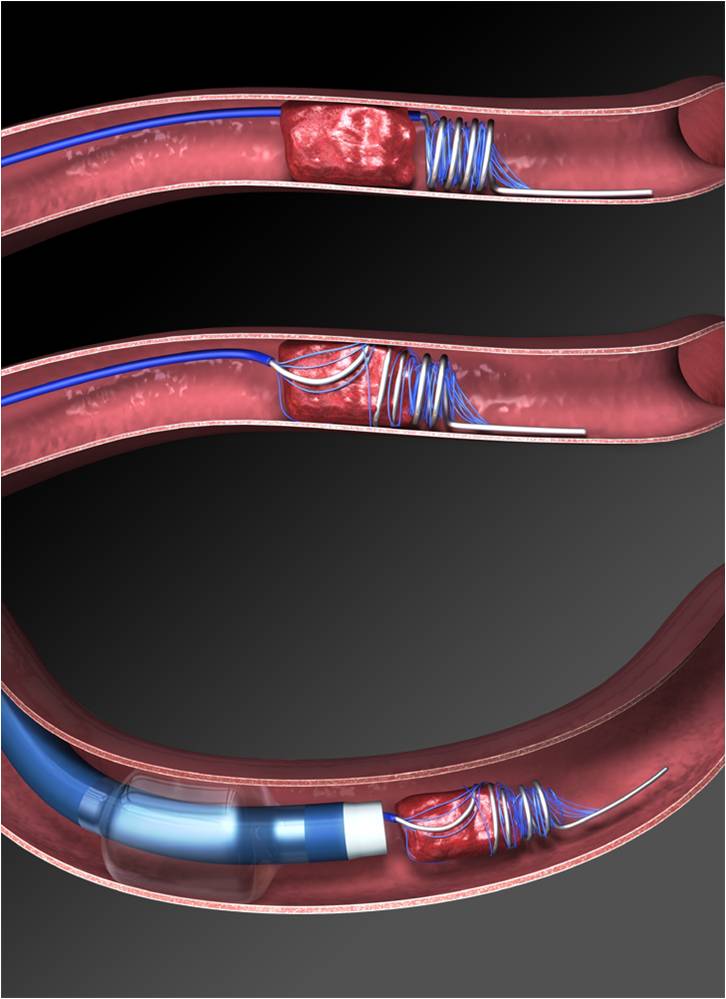Thrombectomy devices are medical devices used to remove blood clots (thrombi) from the blood vessels. Thrombi can occur in veins or arteries and can lead to serious conditions such as stroke, deep vein thrombosis (DVT), and pulmonary embolism (PE).
Thrombectomy devices are typically used in conjunction with other treatments, such as anticoagulants or clot dissolving drugs, to treat these conditions. They can be delivered through a catheter inserted through a small incision in the skin and guided to the site of the clot. The device can then be used to physically remove the clot or to break it down into smaller fragments that can be more easily removed.
There are several types of thrombectomy devices available, including mechanical thrombectomy devices, such as aspiration thrombectomy devices, and chemical thrombectomy devices, such as thrombolytic agents. The choice of device will depend on the location and size of the clot, as well as the individual’s overall health and any underlying conditions.
Thrombectomy is a minimally invasive procedure that has been shown to be safe and effective in the treatment of blood clots. However, it is important to note that the procedure does carry some risks, including bleeding, infection, and damage to surrounding blood vessels. The benefits and risks of thrombectomy should be carefully considered and discussed with a healthcare professional to determine the best approach for individual needs. The global thrombectomy devices market size was valued at $1.3 billion in 2020, and is projected to reach $2.6 billion by 2030, growing at a CAGR of 7.4% from 2021 to 2030.
What is a thrombectomy device?
Thrombectomy devices come in various forms including mechanical thrombectomy devices and aspiration thrombectomy devices. Mechanical thrombectomy devices use rotating or reciprocating action to break up the clot and remove it, while aspiration thrombectomy devices use suction to remove the clot.
Thrombectomy is typically performed using imaging guidance, such as X-ray, ultrasound or computed tomography, to locate the clot and navigate the device to the site of the clot. The procedure is performed using a catheter, which is inserted through a small incision in the blood vessel and guided to the site of the clot.
What is the success rate of thrombectomy?
The success rate of thrombectomy, also known as clot removal, depends on several factors such as the location, size, and age of the clot, as well as the type of thrombectomy device used and the patient’s overall health.
In general, thrombectomy is considered to be a highly effective procedure for restoring blood flow in blocked blood vessels. The success rate of thrombectomy for acute ischemic stroke, for example, is reported to be between 50-80%. The success rate for treating deep vein thrombosis (DVT) and pulmonary embolism (PE) is similarly high, with reported success rates ranging from 80-90%.
However, it is important to note that the success of thrombectomy is only one aspect of the overall treatment outcome. The patient’s recovery from the stroke or other condition may also depend on other factors such as the extent of the damage caused by the clot and the patient’s overall health.
Additionally, the success rate of thrombectomy can vary depending on the experience and skill of the operator and the facility, as well as the patient’s eligibility for the procedure.
Download Free Sample PDF: https://www.alliedmarketresearch.com/request-sample/1608
How is a thrombectomy performed?
A thrombectomy is a minimally invasive procedure performed in a hospital or outpatient setting by a trained healthcare professional, usually an interventional radiologist or a neurointerventionalist. The procedure typically involves the following steps:
- Preparation: The patient will be given a sedative or local anesthesia to help them relax during the procedure. The healthcare professional will also insert a catheter into an artery or vein to access the site of the blood clot.
- Access to the clot: Using imaging guidance, such as X-ray, ultrasound, or MRI, the healthcare professional will guide the catheter to the site of the clot.
- Removal of the clot: Depending on the type of thrombectomy device being used, the healthcare professional may use a mechanical device to physically remove the clot or a chemical agent to break down the clot.
- Recovery: After the procedure, the patient will be monitored for any complications and given instructions for post-procedure care.
The exact steps and duration of the procedure will depend on the individual case and the type of thrombectomy device being used. The procedure is typically performed on an outpatient basis and the patient can go home the same day. The benefits and risks of thrombectomy should be carefully considered and discussed with a healthcare professional to determine the best approach for individual needs.
𝗖𝗼𝗻𝘁𝗮𝗰𝘁:
David Correa
5933 NE Win Sivers Drive
#205, Portland, OR 97220
United States
USA/Canada (Toll Free): +1-800-792-5285, +1-503-894-6022
UK: +44-845-528-1300
Hong Kong: +852-301-84916
India (Pune): +91-20-66346060
Fax: +1(855)550-5975
help@alliedmarketresearch.com


